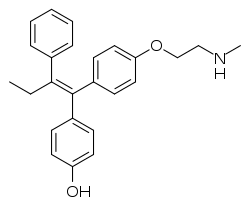Endoxifen
Endoxifen, also known as N-desmethyl-4-hydroxytamoxifen, is a chemical that is under development for estrogen receptor-positive breast cancer.[1] It is also being evaluated as an antipsychotic for treatment of mania and other psychotic disorders.[2]
 | |
| Clinical data | |
|---|---|
| Other names | N-Desmethyl-4-hydroxytamoxifen; 4-Hydroxy-N-desmethyltamoxifen; Desmethylhydroxytamoxifen |
| Identifiers | |
| |
| CAS Number |
|
| PubChem CID | |
| UNII | |
| ChEMBL | |
| PDB ligand | |
| CompTox Dashboard (EPA) | |
| ECHA InfoCard | 100.208.548 |
| Chemical and physical data | |
| Formula | C25H27NO2 |
| Molar mass | 373.496 g·mol−1 |
| 3D model (JSmol) | |
| |
| |
Endoxifen is a nonsteroidal selective estrogen receptor modulator (SERM) of the triphenylethylene group. It is an active metabolite of tamoxifen and has been found to be effective in patients that have failed previous hormonal therapies (tamoxifen, aromatase inhibitors, and fulvestrant).[3][4][5] The prodrug tamoxifen is metabolized by the CYP2D6 enzyme to produce afimoxifene (4-hydroxytamoxifen) and endoxifen.[6]
See also
- List of investigational hormonal agents § Estrogenics
- Droloxifene (3-hydroxytamoxifen)
- Norendoxifen (N-didesmethyl-4-hydroxytamoxifen)
References
- "Z-endoxifen hydrochloride". NCI Drug Dictionary.
- Rankovic Z, Bingham M, Hargreaves R, eds. (2012). Drug Discovery for Psychiatric Disorders. Royal Society of Chemistry. p. 349. ISBN 978-1-84973-365-6.
- Hawse JR, Subramaniam M, Cicek M, Wu X, Gingery A, Grygo SB, Sun Z, Pitel KS, Lingle WL, Goetz MP, Ingle JN, Spelsberg TC (2013). "Endoxifen's molecular mechanisms of action are concentration dependent and different than that of other anti-estrogens". PLoS One. 8 (1): e54613. Bibcode:2013PLoSO...854613H. doi:10.1371/journal.pone.0054613. PMC 3557294. PMID 23382923. Lay summary – Medical Daily (December 12, 2013).
- Wu X, Hawse JR, Subramaniam M, Goetz MP, Ingle JN, Spelsberg TC (March 2009). "The tamoxifen metabolite, endoxifen, is a potent antiestrogen that targets estrogen receptor alpha for degradation in breast cancer cells". Cancer Research. 69 (5): 1722–7. doi:10.1158/0008-5472.CAN-08-3933. PMID 19244106.
- Gingery A, Subramaniam M, Pitel KS, Reese JM, Cicek M, Lindenmaier LB, Ingle JN, Goetz MP, Turner RT, Iwaniec UT, Spelsberg TC, Hawse JR (2014). "The effects of a novel hormonal breast cancer therapy, endoxifen, on the mouse skeleton". PLoS One. 9 (5): e98219. Bibcode:2014PLoSO...998219G. doi:10.1371/journal.pone.0098219. PMC 4031133. PMID 24853369.
- Wilcken N (2016). "Breast cancer: a disease of subtypes". Cancer Forum. 40 (3).
This article is issued from Wikipedia. The text is licensed under Creative Commons - Attribution - Sharealike. Additional terms may apply for the media files.